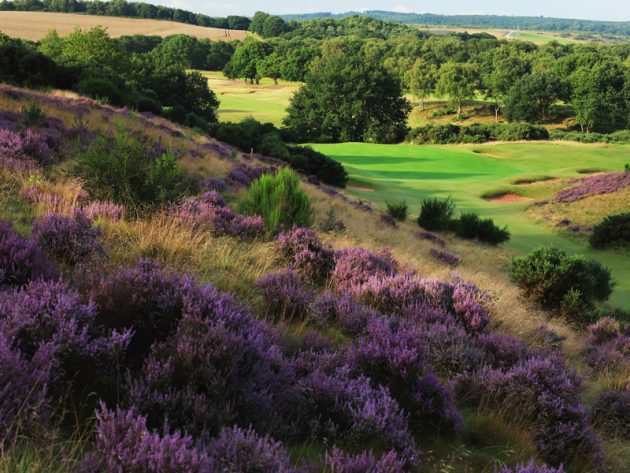Discovering golfing gold in the East Midlands
Fergus Bisset played the superb courses at Notts and Sherwood Forest GCs.


Fergus Bisset played at Notts and Sherwood Forest Golf Clubs and was delighted to discover two of the country’s finest heathland layouts.
During my 35 years I’ve lived at either end of the country. I started out in Kent, moved to Aberdeenshire, went back to the south and am now ensconced again in the good north. Growing up I spent quite a number of hours looking at the middle of the UK from the window of a car or train heading either north or south to visit family. Frequent, repeated glimpses of place names on road signs and station platforms gave me a false affinity with places I knew nothing about first hand. Nottingham, as an example, was somewhere I passed countless times. I watched cricket from Trent Bridge, read about Robin Hood and that nasty Sheriff, rode Raleigh bikes, and felt I knew a bit about the city even though I hadn’t actually visited.
A few years ago though a couple of my pals got jobs in Nottingham and I thus had cause to take a trip there. They were living on one of the leafy avenues in West Bridgford, close to the River Trent – a gorgeous spot. We went for a tour of Trent Bridge, for a stroll on the river bank along Victoria Embankment, took a fascinating trip to Nottingham Castle where I was amazed by the collection in the museum and art gallery – also worth doing is the cave tour to explore the network of tunnels carved into the sandstone beneath the castle. We went to a number of great pubs (well, I hadn’t seen them for a while after all. My favourite was the Canal House with the canal actually going into the building, plus a great outdoor seating area.) In general I was just seriously impressed by the place – a busy, friendly and exciting small city. This June I returned to the East Midlands to enjoy more of what the area has to offer. This time, though, I went with my golf clubs in the boot.

Notts Golf Club is to be found just to the north of Nottingham, only a few miles from junction 27 of the M1. But it couldn’t feel further removed from the rush and hubbub of the city and motorway. As you turn into the course, a single track road takes you, innocuously at first, between fields and down through trees, leading on out into a hidden swathe of beautiful heathland. Driving up to the attractive clubhouse, past the extensive practice area with a dew glistening on the wisps of long grass bordering verdant, sweeping fairways, I had a feeling I was about to be let in on a rather fabulous secret.
Notts Golf Club was founded in 1887 at the instigation of the Reverend Arthur Hamilton Baynes. At first there were just five members but by the end of the following year there were over 40 and they were playing competitions over a piece of land at Bulwell Forest Station. The course there became 18-holes and the club hosted exhibition matches featuring the likes of Vardon, Taylor and Braid. But the land over which the course was laid out became increasingly popular with the non-golfing public who began to play football and cricket and to take picnics on the greens. In the late 19th century it was clear a move was required and so the club relocated to the present site at Hollinwell.
The course was designed by Willie Park Junior and it opened for play in 1901. Alterations were made by Tom Williamson in 1912 and since then, save for necessary additions to the length of the layout, the track has remained largely unchanged.
Over the years, Notts GC has frequently welcomed prestigious championships, including the News of the World Matchplay, the Dunlop Masters and the John Player Classic. Notts hosted the 2012 Boys Amateur Championship won by Matt Fitzpatrick and, in 2015, the Brabazon Trophy won by Cormac Sharvin. Hollinwell is a course with a great pedigree, presenting a challenge sufficient to test the very best. As, I’m rather far removed from the “very best” I approached the 1st tee with more than a degree of trepidation.
Get the Golf Monthly Newsletter
Subscribe to the Golf Monthly newsletter to stay up to date with all the latest tour news, equipment news, reviews, head-to-heads and buyer’s guides from our team of experienced experts.
The 1st hole though is relatively gentle: a short, straightaway par-4 with bunkers guarding either side of the fairway. This is one to ease you in, although stray left or right off the fairway and you’ll get your first taste of Hollinwell’s testing rough. When I played, the longer grass wasn’t so brutal that you wouldn’t find your ball but it was generally penalising enough to demand a shot back towards the fairway rather than a slash towards the green – tough but fair.
Rules video - identifying your ball in the rough:
The approach to the 1st is slightly downhill and when the greens are firmer through the summer months, you’ll likely need to land just short to allow the ball to bounce and run up across the springy heathland turf.
Having navigated this friendly opener, the test ramps up immediately on the 2nd. It’s a long par-4 playing uphill all the way, turning from right to left with heather down the left side. The temptation is to cut a portion off the corner but this brings the tangly stuff into play. The safe tee shot is to the right but this leaves a long and difficult second to a raised green. This is the first of many excellent long par-4s on this course. It’s a layout that demands good ball striking – not only because finding the fairways is imperative but also because a number of the targets require an accurate and flighted approach.
Although, there are a series of testing holes – the uphill 4th in particular, the front nine is the easier of the two at Notts and the challenge builds as you make your way into a superb run of holes after the turn.
The 11th snakes up a natural valley to a small green. It’s only 360 yards but it requires two precise shots. The 12th is a cracking long par-4 that demands a strategic approach. At 474 off the backs, you feel like you must hit driver, but this could be too much as the fairway dips into a bowl where your ball could find rough. The best play is to lay back onto a plateau leaving yourself a clear, albeit, long second to the green.

Although Notts is a long course – over 7,200 yards from the very back pegs, it’s a requirement for placement rather than power that is to the fore here. Finding the short stuff is imperative both from the tee and then on approach. This is a difficult track but it must be stressed, not unfairly so. It’s simply a fantastic design where each hole asks a clear question of the player and, if they deliver the answer, they’ll be suitably rewarded. The par-5 17th provides a great example. The fairway is further right than it first appears and the temptation is, once again, to cut the corner by aiming close to the bunkers on the apex of the right to left turn. But if you do so, you’re liable to find either those bunkers or the rough to their left. If you can bring yourself to hit for the meat of the fairway, you’ll have a chance to reach in two.
Back in the clubhouse after the round, enjoying a rather splendid pint of Captain’s Pale Ale, we reflected on the game and could find no fault. This is a wonderful, varied heathland layout comparable to the best the home counties have to offer. It delivers peaceful seclusion, immaculate surfaces, historic and effective design making use of the natural terrain, a firm but fair challenge and, overall, a thoroughly memorable experience. I was hoping for more of the same the following day at Sherwood Forest GC and I wasn’t to be disappointed.

A 15-minute drive north and east of Hollinwell, on the fringes of Mansfield, Sherwood Forest is another historic club, dating from 1895. They have been at the same site since 1912 playing over a course originally laid out by Hary Colt but remodelled by James Braid in the 1920s. Like at Hollinwell, the track has remained basically unchanged since the early part of the 20th century. That’s partly testament to the skill of those great men as course designers and partly down to the exceptional terrain over which this great track is set.
Playing out from in front of the comfortable and welcoming clubhouse, alongside the bronze stag that keeps watch over the course, the 1st hole at Sherwood Forest is a short, tactical par-4 that requires a straight drive stopping short of a well-placed bunker around 30 yards from the green. Like at Notts, the opening is relatively gentle but the challenge increases on the left to right second, heather waits to the left, trees and rough to the right, Straight ahead bunkers loom ominously, but in fact there’s quite a bit of space between them.
With punishing rough and bunkers protecting the edges of most holes here, tee shots are visually intimidating here but the landing areas are reasonably generous. The key to success is to win the mental battle and trust that a good swing, aimed on a reasonable line will find a sensible spot. Often driver is not the correct play though, and even 3-wood might be too much. The 6th hole provides a good example. Although it measures around 400 yards, the safe play off the tee is a long iron or hybrid to lay-up short of bunkering some 240 yards out. This is a course where you must be patient and use your golfing brain. I don’t have one and swept a beautifully struck 3-wood straight into one of those traps on the 6th.
The greens at Sherwood Forest deserve special mention. I’d heard of their good reputation and they didn’t disappoint. Despite some very heavy rain in the day or two before we played, they were exceptionally true and very fast indeed – a real joy to putt on and even I was able to knock in a few decent length putts.

The start of the run for home at Sherwood Forest is excellent and the stretch from the 11th to the 14th is the most difficult on the course. The 11th is slightly downhill and plays from left to right. A bunker off the tee looms large but there’s plenty of room to the left. The approach must miss a clamouring gaggle of bunkers placed to catch a variety of misses.
The 12th requires a strong drive and straight approach to a green framed by trees. Both par-4s, the 13th and 14th turn from right to left and both ask for two well struck shots if you’re to reach in regulation. Get through these four holes in par and you’ve played very well indeed.
Played over springy heathland turf, across fairways lined by heathers and a fine variety of trees, this is a supremely attractive setting for golf and the terrain is ideally suited for the game. Sherwood Forest is another gem of a heathland track and one that deserves recognition for the quality of its layout and presentation.
Once again, the clubhouse provided a grand setting for a debrief. Sitting in comfy chairs below walls lined with honours boards we agreed we’d just played the second of two exceptional heathland courses. These are two tracks to rival any inland layouts in the UK and, if you haven’t done so already, I can’t recommend highly enough that you travel to Nottingham to experience them for yourselves.
For me now, Nottingham is not just a sign on the M1 it’s a vibrant and fascinating city packed with history and culture. It’s also a fantastic venue for a golfing break; home to some of the best heathland golf in the country.

Essential info
Notts Golf Club (Hollinwell) W: nottsgolfclub.co.uk T: 01623 753225 Stats: Par 72, SSS 76, 7,250 yards (off championship tees) Par 72, SSS 73, 6,619 yards (off yellow tees) GF: £85 per round, £120 for 36 holes (June to September)
Sherwood Forest Golf Club W: sherwoodforestgolfclub.co.uk T: 01623 626689 Stats: Par 70, SSS 74, 6,806 yards (off championship tees) Par 71, SSS 71, 6,281 yards (off yellow tees) GF: £75 per round, £95 for 36 holes (May to September)
Five more notable courses in the Nottingham area
Notts and Sherwood Forest GC are by no means not the only quality venues in the East Midlands:
Coxmoor GC W: coxmoorgolfclub.co.uk
Another excellent heathland track between Nottingham and Mansfield. Coxmoor has been a regular host to top level competition. Greg Owen and Oliver Wilson are honorary members.
Worksop GC W: worksopgolfclub.com
Founded in 1914, the course at Worksop GC is set on the edge of Sherwood Forest and on the boundary of the National Trust’s Clumber Park. Lee Westwood played here as a youngster.
Wollaton Park GC W: wollatonparkgolfclub.com
This is a fine parkland course set in over 500 acres of the Wollaton Park estate. Designed by Tom Williamson, the course dates from the mid 1920s.
Beeston Fields GC W: beestonfields.co.uk
A beautiful parkland golf course designed, as so many in this area were, by Tom Williamson and opened for play in the mid 1920s. Also of note is the stunning mid 19th century clubhouse.
Stanton-on-the-Wolds GC W: stantongolfclub.co.uk
This is a lovely parkland course, just south of Nottingham. Look out for the ridge and furrow fairways – rumples created by traditional farming techniques of years gone by.

Fergus is Golf Monthly's resident expert on the history of the game and has written extensively on that subject. He has also worked with Golf Monthly to produce a podcast series. Called 18 Majors: The Golf History Show it offers new and in-depth perspectives on some of the most important moments in golf's long history. You can find all the details about it here.
He is a golf obsessive and 1-handicapper. Growing up in the North East of Scotland, golf runs through his veins and his passion for the sport was bolstered during his time at St Andrews university studying history. He went on to earn a post graduate diploma from the London School of Journalism. Fergus has worked for Golf Monthly since 2004 and has written two books on the game; "Great Golf Debates" together with Jezz Ellwood of Golf Monthly and the history section of "The Ultimate Golf Book" together with Neil Tappin , also of Golf Monthly.
Fergus once shanked a ball from just over Granny Clark's Wynd on the 18th of the Old Course that struck the St Andrews Golf Club and rebounded into the Valley of Sin, from where he saved par. Who says there's no golfing god?
-
 Volvo China Open 2025 Picks, Odds And Predictions
Volvo China Open 2025 Picks, Odds And PredictionsFollowing a break for The Masters, the DP World Tour returns for the final two weeks of its Asian Swing and the Volvo China Open is the penultimate event
By Jonny Leighfield
-
 Rory McIlroy's Sports Psychologist Explains Why He 'Didn't Talk' To Bryson DeChambeau In Masters Final Round
Rory McIlroy's Sports Psychologist Explains Why He 'Didn't Talk' To Bryson DeChambeau In Masters Final RoundDeChambeau raised eyebrows at Augusta National when claiming that McIlroy wouldn't engage in conversation during the final round of The Masters
By Jonny Leighfield